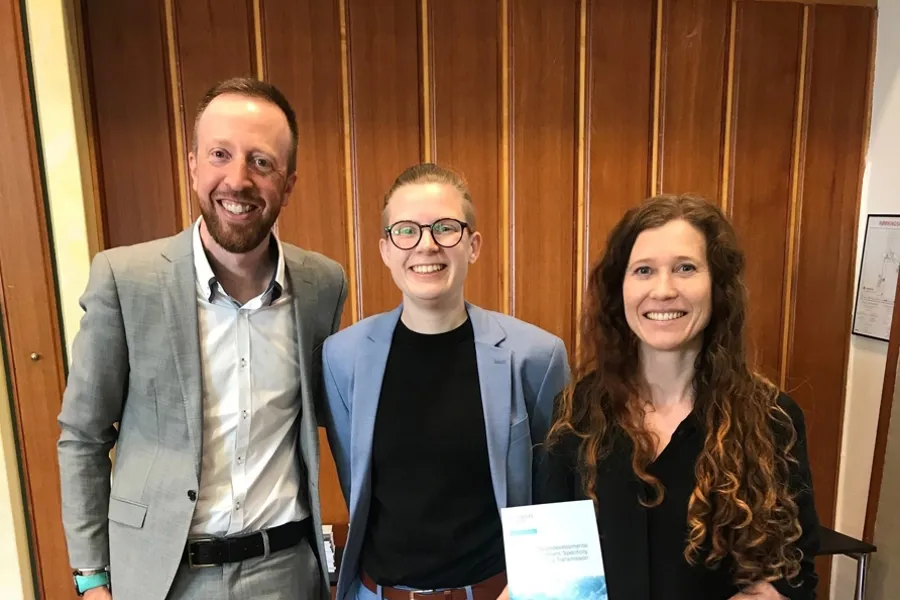Disputas Laura Hegemann
Master Laura Hegemann ved Nic Waals Institutt, Lovisenberg Diakonale Sykehus disputerte 22. mai 2024

Tittele på avhandlingen er Etiology of Neurodevelopmental Traits: Measurement, Specificity, and Within-Family Transmission
Laura Hegemann tilhører PaGE-gruppen.
Engelsk sammendrag
Neurodevelopmental conditions are a diverse category of conditions, primarily diagnosed in childhood due to difficulties arising from differences or delays in the development of a range of neuropsychological domains, such as language and motor development or attention regulation. Neurodevelopmental conditions, such as ADHD and autism, frequently co-occur with each other, as well as other mental and physical health conditions. Understanding the etiology of neurodevelopmental conditions and their potential shared and differing factors can help identify ways to best support individuals with these conditions and provide a basis to study etiological overlap with other mental and physical health conditions.
Traits generally associated with neurodevelopmental conditions, such as difficulties with language, communication, and attention, are also relatively common in the general population. Examining specific neurodevelopmental traits and their overlap with neurodevelopmental conditions across development is critical for understanding the development and co-occurrence of these conditions. This thesis relies on data from the Norwegian Mother, Father, and Child Cohort Study (MoBa), which includes detailed questionnaire data on neurodevelopmental traits throughout development. The rich phenotyping data available in MoBa and other large birth cohort or general population studies puts these studies in a valuable position to contribute to the etiological understanding of the development of neurodevelopmental conditions and co-occurring difficulties. This is one of the many reasons why data collected from population-based cohorts is valuable, as it provides a broader range of information at various stages of development with sample sizes that may not be achieved relying solely on clinical data. Additionally, these cohorts allow for studying these traits before or around the time when neurodevelopmental diagnoses are commonly made. However, it is important to note that population-based cohorts will have a relatively small number of individuals with neurodevelopmental conditions. Therefore, to fully understand the link between neurodevelopmental conditions and traits in the general population, it is essential to investigate the measurement, factor structure, and genetic architecture of neurodevelopmental traits in the general population and their overlap with neurodevelopmental conditions. This was the overall goal of the thesis.
The first paper in the thesis addresses the measurement of neurodevelopmental traits, specifically repetitive and restrictive behaviors and interests, as well as social and communication traits. In this paper we find that, in a general population, the Social Communication Questionnaire (SCQ) measures these traits equivalently across males and females. However, there is evidence for differences in how the items measure the underlying trait dimensions across those with and without autism, suggesting careful consideration of the interpretation of findings using this instrument in general population samples.
The factor structure underlying neurodevelopmental traits in the general population is investigated in both the first and second papers of this thesis. Results from both papers indicate many specific dimensions underlying neurodevelopmental traits, more so than if these trait dimensions corresponded directly to the diagnostic criteria domains for neurodevelopmental conditions. Additionally, we find that early variation in neurodevelopmental traits at age 3 in the general population is associated with receiving various diagnoses of neurodevelopmental conditions, psychiatric inpatient stays, and perceived impact in daily life at later ages.
The second and third papers of this thesis investigate the genetic architecture, genetic overlap with neurodevelopmental conditions, and contribution of indirect genetic effects neurodevelopmental traits. Indirect genetics effects being, in the context of this thesis, the genetic effects of parents on their children’s traits over and above genetic transmission. In these studies, we find that common genetic variation contributes to early differences in neurodevelopment to varying degrees across different areas of development. We find that the common genetic variation influencing these early differences includes genetic liability to neurodevelopmental conditions. Additionally, while direct genetic effects contribute to most areas of early neurodevelopment, indirect genetic effects appear to be important contributors to variability in early measures of attention, hyperactivity-impulsivity, and repetitive and restrictive behaviors and interests.
Overall, the work of this thesis provides a basis for how early neurodevelopmental traits in the general population are measured, how they are related to each other and to neurodevelopmental conditions, and the genetic contributions to their variability. This can be used to inform how studies of neurodevelopmental traits in general population samples can best be used in etiological work, as well as provide potential avenues of inquiry on shared and differing factors in the development of neurodevelopmental conditions and traits